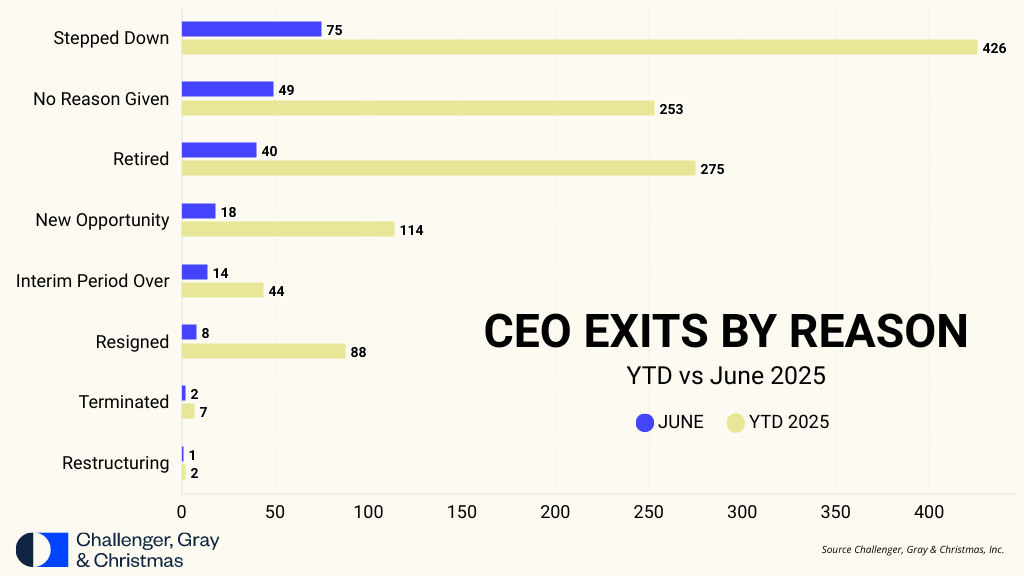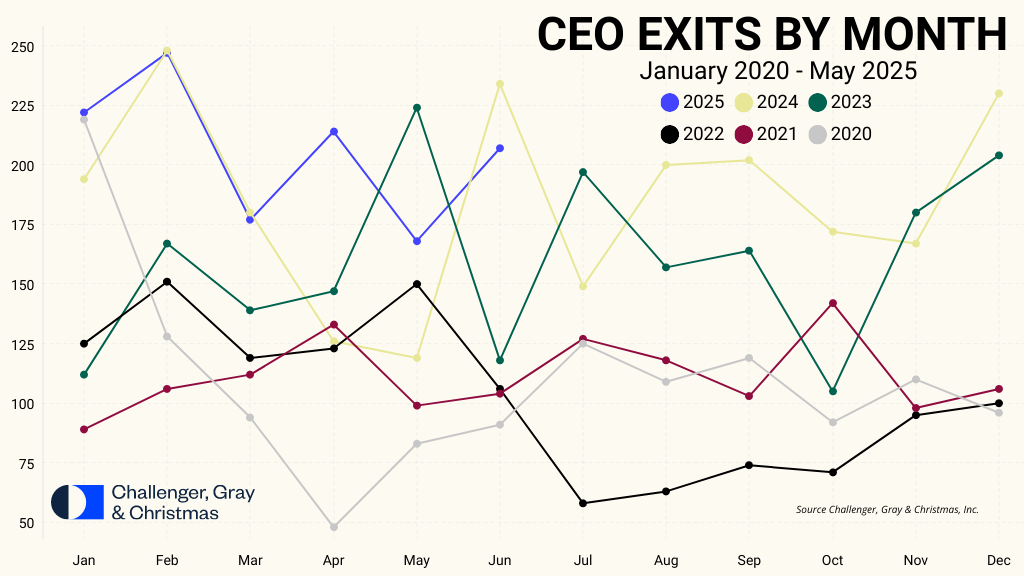
Jul 28 CEOs Leave at a Faster Clip in June 2025; Boards Experiment with Interim Leadership
Challenger CEO Report: The Rise of the CEO Gig Economy Amid Record-Breaking Turnover
Published June 28, 2025
The number of CEO changes at U.S. companies rose 23% from 168 in May to 207 in June. This is down 12% from the 234 CEO exits that occurred in the same month one year prior, according to a report released Monday by global outplacement and business and executive coaching firm Challenger, Gray & Christmas.
Through the first half of the year, 1,235 CEOs left their posts, up 12% from the 1,101 CEOs who left their posts during the same period last year. This represents the highest YTD total on record. Challenger began tracking CEO exits in 2002.

WOMEN CEOs
The rate of new CEOs who are women is hovering at 25% and well below the 28% of new women CEOs appointed during the same period last year.
WHAT INDUSTRIES ARE SEEING TURNOVER?
Government/Non-Profit continues to lead all industries with 256 CEO exits through June 2025, 44 of which occurred in June. Of those, 39 were in Non-Profits. This represents a slight 1.6% increase from the 252 CEO exits in this sector during the same period last year.
Technology follows with 138 CEO exits through June 2025, including 24 in June. While slightly below the February peak of 31, it remains one of the highest monthly totals this year. The sector has seen a 16% increase from the 119 CEO exits recorded through June 2024.
Health Care/Products companies have announced 121 CEO exits through June 2025, up 20% from 101 exits during the same period last year.
Hospitals, a subset of the Health Care/Products sector, have reported 68 CEO exits through June 2025, 17 of which occurred in June. This is up slightly — about 3% — from the 66 hospital CEO exits recorded through June 2024.
Financial firms announced 11 CEO exits in June, bringing the year-to-date total to 76 — a 29% increase from the 59 CEO exits reported through June 2024.
THE CEO GIG ECONOMY?
Challenger is tracking an emerging trend of companies’ reliance on interim leadership. Through the first 6 months of 2025, 15% of new CEOs have been named on an interim basis, compared to 9% during the same period last year.
“It’s common for an interim head to take over when a departing CEO leaves, but this is a higher rate than we saw in previous years. With the uncertainty and disruptions across industries, trying a leader on a non-permanent basis may seem attractive to boards right now,” said Andy Challenger, workplace and labor expert for Challenger, Gray & Christmas.
Companies were fairly evenly split in choosing interim leaders, though they tended to choose candidates from their own pipelines: 53% were selected from within the organization, while 47% came from outside. When it came to making the role permanent, internal leaders and external candidates had the same chance with 20% of each ultimately named on a permanent basis.
“With growing uncertainty across the economy, shifting corporate values like DEI, the impact of tariffs, potential deregulation, evolving consumer behavior, and the rapid implementation of new technologies such as AI, identifying the right leader for long-term success has become increasingly difficult,” said Challenger.
“At the same time, more executives are embracing the increasingly attractive option of short-term CEO roles, essentially participating in a ‘CEO gig economy,’” he added. “Many of these leaders, some of whom stepped away after guiding organizations through the pandemic, are now returning on their own terms. Interim roles offer them the opportunity to take on fresh challenges, keep their skills sharp, and maintain flexibility over their workload and boundaries.”

While this arrangement offers flexibility and fresh energy, it can come with real risks for organizations.
“When teams know their leader could leave at any moment, it’s harder to build lasting cohesion or trust. Time and effort may be spent trying to align around a vision that ultimately walks out the door, sometimes before key goals are achieved,” said Challenger.
“This kind of leadership churn can also disrupt company culture. Uncertainty at the top may lead to confusion, erode morale, or even create a more toxic environment, particularly if employees feel their concerns aren’t being addressed or if priorities keep shifting. Leadership transitions are already high-risk periods for attrition; when employees sense instability or lack of direction, they’re more likely to disengage or leave, taking institutional knowledge and momentum with them,” he added.




